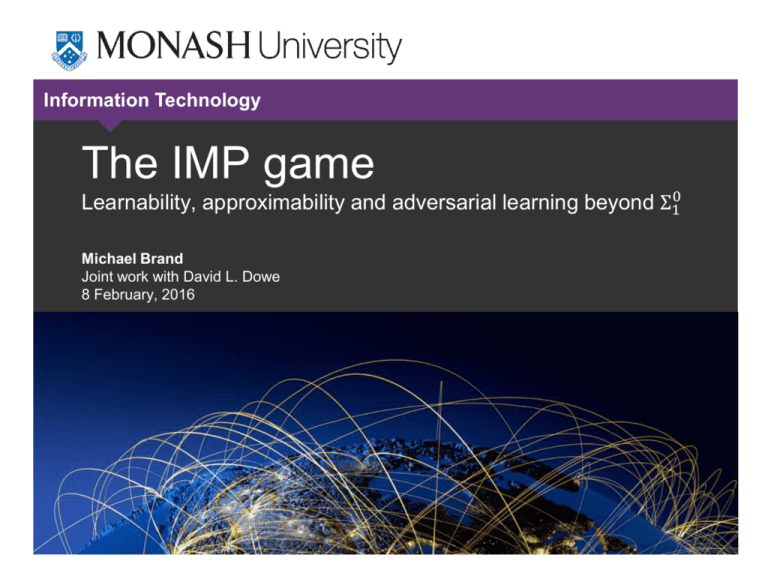Document
advertisement

Information
Technology
Information
Technology
The IMP game
Learnability, approximability and adversarial learning beyond Σ10
Michael Brand
Joint work with David L. Dowe
8 February, 2016
Three questions
Approximability
– How much can (well chosen) elements from one set be made to
resemble (arbitrary) elements from another set?
– We consider languages and
Learning
– How well can one predict a sequence by seeing its past
elements?
Adversarial learning
– Two adversaries try to predict each other’s moves and capitalise
on the predictions. How well can each do?
– Very hot topic, currently:
• Online bidding strategies.
• Poisoning attacks.
The IMP game
8 February, 2016
2
Major results
Approximability
– Halting Theorem: there is a co-R.E. language that is different to
every R.E. language.
– Our result:
Theorem 1: There is a co-R.E. language 𝐿, such that every R.E. language
has a dissimilarity distance of 1 from 𝐿.
– Essentially, it is as different from any R.E. language as it is
possible to be.
The IMP game
8 February, 2016
3
Major results (cntd)
Informally:
Learning
– Turing machines can learn by example beyond what is
computable.
– In fact, they can learn all R.E. and all co-R.E. languages (and
more).
Adversarial learning
– In an iterated game of matching pennies (a.k.a. “odds and
evens”), the player choosing “evens” has a decisive advantage.
The IMP game
8 February, 2016
4
Caveat
Conclusions inevitably depend on one’s base definitions.
– For approximability, for example, we used the DisSim metric, but
other distance metrics would have yielded potentially different
results.
The same goes for our definition of “to learn” that underpins the
“learning” and “adversarial learning” results.
The literature has many definitions of “learnability”:
– Solomonoff
– E. M. Gold
– Statistical Consistency
– PAC
– etc.
Our definition is not identical to any of these, but has a resemblance to
all of them.
The IMP game
8 February, 2016
5
Our justifications
We give a single, unified framework within which all three problems
(approximability, learnability, adversarial learning) can be investigated.
We want to explore the “game” aspects of adversarial learning, so
naturally integrate tools from game theory (e.g., mixed strategies, Nash
equilibria).
– We begin by analysing adversarial learning, then take the other
cases as special cases.
– Traditional approaches typically begin with “learning”, and need
special provisions for adversarial learning, sometimes losing
entirely the “game” character and reducing the process to a oneplayer game.
– We believe that our approach, retaining the “game” elements, is
more natural.
The results are interesting!
The IMP game
8 February, 2016
6
The IMP set-up
The IMP game
8 February, 2016
7
A game of matching pennies
Player “=“
Player “≠“
Accept/
Reject
Accept/
Reject
The IMP game
8 February, 2016
8
An iterated game of matching pennies
Player “=“
Player “≠“
Accept/
Reject
Agent
Accept/
Reject
Agent
Final payoffs?
Inspector
The IMP game
8 February, 2016
9
Why the strange payoffs?
They are always defined.
The game is zero-sum and strategically symmetric, except for the
essential distinction between a player aiming to copy (Player “=”, the
pursuer) and a player aiming for dissimilarity (Player “≠”, the evader).
The payoff is a function solely of the {𝛿𝑖 } sequence. (This is important
because the agents only have visibility into this, not full information
regarding the game's evolution.)
Where a limit exists (in the lim sense) to the percentage of rounds to be
won by a player, the payoff is this percentage.
– In particular, note that when the payoff functions take the value 0
or 1, there exists a limit (in the lim sense).
The IMP game
8 February, 2016
10
An iterated game of matching pennies
Player “=“
Player “≠“
Accept/
Reject
Agent
Strategy
Mixed strategy = distribution
Accept/
Reject
Agent
Strategy
Inspector
Mixed strategy = distribution
The IMP game
8 February, 2016
11
The IMP game: 𝑰𝑴𝑷(𝚺= , 𝚺≠ )
Accept/
Reject
L=
Agent
Accept/
Reject
L≠
Agent
• Deterministic. (Or else Nash equilibrium is 50/50 independent coin tosses.)
• Chosen from 𝚺= and 𝚺≠ , respectively.
• Example: if 𝚺= =𝚺≠ = R.E. languages, agents are Turing machines and are not
required to halt (in order to reject).
• Choice of both agent is performed once, independently, at the beginning of the
game. Agents have no direct knowledge of each other’s identity.
The IMP game
8 February, 2016
12
The IMP game: 𝑰𝑴𝑷(𝚺= , 𝚺≠ )
Player “=“ strategy
Player “≠“ strategy
Accept/
Reject
D=
Accept/
Reject
L=
Agent
L≠
D≠
Agent
• Distributions over 𝚺= and 𝚺≠ , respectively.
• Completely unconstrained. E.g., do not need to be computable.
• Game payoffs are the expected payoffs for the game, given independent
choices of agents from the two distributions.
The IMP game
8 February, 2016
13
The IMP game: 𝑰𝑴𝑷(𝚺= , 𝚺≠ )
Player “=“ strategy
Player “≠“ strategy
Accept/
Reject
D=
L=
Accept/
Reject
L≠
D≠
Agent
Agent
• Oracle.
Observation:
• Does not need to be
computable.
The key to enabling the learning
from examples of incomputable
functions is to have a method to
generate the examples...
• Performs a xor over
accept/reject choices.
Inspector
The IMP game
8 February, 2016
14
The IMP game: 𝑰𝑴𝑷(𝚺= , 𝚺≠ )
Player “=“ strategy
Player “≠“ strategy
Accept/
Reject
D=
L=
L≠
D≠
Agent
• Agents are effectively
“restarted” at every
iteration.
• The feedback from the
inspector is their input
string.
Accept/
Reject
Agent
• The feedback is only {𝛿𝑖 },
the list of previous rounds’
winners.
Inspector
• Note: the bit-length of the
input to the agents is the
round number.
The IMP game
8 February, 2016
15
Reminder of some
(standard) definitions we’ll
use
The IMP game
8 February, 2016
16
The Arithmetical Hierarchy
Δ01 - The decidable (recursive) languages.
Σ𝑖0
Π𝑖0
Δ0𝑖
Σ10 - The R. E. languages. (TM acceptable.)
Π10 - The co-R. E. languages.
Δ02 , Σ20 , Π20 - Same, but with an Oracle for halting.
Σ30
Π30
Δ03
Δ03 , Σ30 , Π30 - Same, but with an Oracle for halting of
level 2 machines.
Δ0𝑖 , Σ𝑖0 , Π𝑖0 - etc..
Σ20
Π20
Δ02
Σ10
Π10
Δ01
The IMP game
8 February, 2016
17
Nash equilibrium
A basic concept from game theory.
Definition: a pair of (mixed) strategies (𝐷=∗ , 𝐷≠∗ ), such that neither player
can improve their expected payoff by switching to another strategy
given that the other player maintains its equilibrium strategy.
We define
Where minmax=maxmin, this is called the “value” of the game. Notably,
it may be that no strategy pair attains the value, even if it exists. (The
space of distributions is not compact.)
By definition, the payoff for any Nash equilibrium pair equals both.
The IMP game
8 February, 2016
18
Warm-up: halting Turing
machines
The IMP game
8 February, 2016
19
Characterisation of Nash equilibria
Theorem 2: The game 𝐼𝑀𝑃(𝛥10 , 𝛥10 ) has no Nash equilibria.
Proof.
– Consider a (necessarily incomputable) enumeration, L0, L1,...,
over 𝛥10 .
– ∀𝐷≠ ∀𝜀 ∃𝑋, 𝑠. 𝑡. 𝑃𝑟𝑜𝑏 ∃𝑥 ≤ 𝑋, 𝐿≠ = 𝐿𝑖 ≥ 1 − 𝜖; 𝐿≠ ~𝐷≠ .
– Implement L= (pure strategy) as follows:
The IMP game
8 February, 2016
20
Only change needed.
–
–
–
–
Will make at most X errors w.p. 1-ε, so maxmin=0.
Note: L0,...,LX can be finitely encoded by (finite) T0,...,TX.
Symmetrically, for any D=, define L≠ to prove minmax=1.
Because maxmin≠minmax, no Nash equilibrium exists.
The IMP game
8 February, 2016
21
The general case
The IMP game
8 February, 2016
22
Adversarial learnability
Definition: 𝚺≠ is adversarially learnable by 𝚺= if minmax(𝚺= , 𝚺≠ )=0. (If it
is “adversarially learnable by 𝚺𝟏𝟎 ”, we simply say “adversarially learnable”.)
Example: ∀𝑖, 𝛥0𝑖 is not adversarially learnable by 𝛥0𝑖 .
Proof. Same construction as for Δ01 shows minmax(Δ0𝑖 , Δ0𝑖 )=1.
Theorem 3: IMP(𝛴10 , 𝛴10 ) has a strategy L= that guarantees S(L=,L≠)=0 for
all L≠ (and therefore all D≠). In particular, 𝛴10 is adversarially learnable.
Proof. implement L= as follows:
Can only lose a finite number of rounds against any
agent!
The IMP game
8 February, 2016
23
Adversarial learnability (cntd)
Corollary: For all i>0, 𝛴𝑖0 is adversarially learnable by 𝛴𝑖0 but not by 𝛱𝑖0 ;
𝛱𝑖0 is adversarially learnable by 𝛱𝑖0 but not by 𝛴𝑖0 .
Proof. Previous algorithm shows learnability. Non-learnability is shown by
symmetry: if Player “=“ has a winning strategy, the other does not.
The IMP game
8 February, 2016
24
Conventional learning
The IMP game
8 February, 2016
25
Nonadaptive strategies
Definition: A nonadaptive strategy is a language, L, such that
∀𝑢, 𝑣, 𝑢 = 𝑣 ⇒ (𝑢 ∈ 𝐿 ⟺ 𝑣 ∈ 𝐿) , where |u| is the bit length of u.
Respective to an arbitrary (computable) enumeration w1, w2,... over the
complete language, we define NA(L) s.t., 𝑥 ∈ 𝑁𝐴(𝐿) ⟺ 𝑤 𝑥 ∈ 𝐿.
Furthermore, 𝑁𝐴 Σ = {𝑁𝐴(𝐿)|𝐿 ∈ Σ}.
A nonadaptive agent is one that decides by the round number, ignoring
the outcomes from all previous rounds. It effectively generates a
constant string of bits, regardless of the actions of the other player.
By constraining one player to be nonadaptive, we can analyse how well
the other player can predict its (nonadaptive) bits.
The IMP game
8 February, 2016
26
Conventional learnability
Definition: 𝚺≠ is (conventionally) learnable by 𝚺= if minmax(𝚺= ,
NA(𝚺≠ ))=0. (If it is “learnable by 𝚺𝟏𝟎 ”, we simply say “learnable”.)
Example: For all i>0, Σ𝑖0 is learnable by Σ𝑖0 . In particular, Σ10 is learnable.
Proof. We have already shown that Σ𝑖0 is adversarially learnable by Σ𝑖0 ,
and NA(Σ𝑖0 ) is a subset of Σ𝑖0 .
In other words, we are weakening the player that is already weaker.
It is more rewarding to constrain Player “=“ and to consider the game
IMP(NA(Σ𝑖0 ), Σ𝑖0 ).
Note, however, that this is equivalent to IMP(Σ𝑖0 ,NA(Π𝑖0 )) under role
reversal.
Theorem: 𝛱10 is learnable.
Corollary: For all i>0, Σ𝑖0 can learn a strict superset of Σ𝑖0 ⋃Π𝑖0 .
The IMP game
8 February, 2016
27
Proof (general idea)
Suppose each player had knowledge (from the inspector) not only of
{𝛿𝑖 }, but also of O=(i) and O≠(i), the output sequences of the two players.
An R.E. Player “=“ could simulate a co-R.E. player on all even rounds
2i, by outputting f(2i), for any R.E. f, on round 2i-1, then outputting “not
O=(2i-1)” on round 2i.
In fact, the player could win 100% of the rounds by sacrificing k rounds
each time (for an increasing k) in order to pre-determine 2k-1 future bits.
This is done by binary searching over the Hamming weight.
– When reaching the 2k-1, it will simulate all machines in parallel
until the right number halts.
The IMP game
8 February, 2016
28
Proof (cntd)
Complication #1: We only have {𝛿𝑖 }.
– Solution: We can tell O=(i) from {𝛿𝑖 } if we know O≠(i). We can
therefore do an exploration/exploitation trade-off: use some of the
2k-1 bits that we can predict in order to bootstrap the next
prediction batch.
– We still need to guess a little (2 bits) in order to bootstrap the
entire process.
Complication #2: How do we guess these 2 bits?
– Solution: We use a mixed strategy of 4 agents with different
guesses. This ensures 25% of success.
Complication #3: How do we get from 25% to 100%?
– Solution: Using the {𝛿𝑖 }, we can verify 100% of our predicted bits
(all of the “exploitation” bits). We can tell when we’re wrong and
try guessing again. In a mixed strategy with 4t agents, we can
ensure t independent guess attempts for each.
The IMP game
8 February, 2016
29
Proof (cntd)
Complication #4: After the first guess, all remaining t-1 guesses happen
at different rounds among the different agents. How can we ensure a
25% success rate for each guess?
– Solution: We make sure all guesses are synchronised between
agents. The way to do this is to pre-allocate for each of the t
guesses an infinite sequence of rounds, such that in total these
rounds amount to a density of 0 among all rounds. Each guess
retains its pre-allocated rounds until it is falsified. Guesses all
happen in pre-allocated places within these pre-allocated rounds.
– The remaining rounds (forming the overwhelming majority) are
used by the current “best guess”: the lowest-numbered hypothesis
yet to be falsified.
– Total success rate: 1-0.75t, for a sup of 1, as required.
The IMP game
8 February, 2016
30
Proof (cntd)
Complication #5: But we don’t know which co-R.E. function to emulate...
– Solution: Instead of having t hypotheses, we have an infinite
number of hypotheses, t for each co-R.E. function. We enumerate
over all.
– We pre-allocate an infinite number of bits to each of these infinite
hypotheses, while still maintaining that their total density is 0.
Notably, if our learner was probabilistic, there was no need for a mixed
strategy.
– Although this, too, has its own complications...
However, we are able to prove that no pure-strategy deterministic agent
can learn the co-R.E. languages.
This is a case where stochastic TMs have a provable advantage.
The IMP game
8 February, 2016
31
Approximation
The IMP game
8 February, 2016
32
When both players are constrained to be nonadaptive, they have no
chance to learn from each other. Their outputs are fixed and
predetermined and that game’s outcome is only the result of their
dissimilarity.
Definition: 𝚺≠ is approximable by 𝚺= if minmax(NA(𝚺= ), NA(𝚺≠ ))=0. (If it
is “approximable by 𝚺𝟏𝟎 ”, we simply say “approximable”.)
Here it is clear that for any Σ,
because L= can always be chosen to equal L≠.
However, in this case mixed strategies do make a difference.
We do not know the exact value of minmax(NA(Σ10 ),NA(Σ10 )), but we do
know the following.
The IMP game
8 February, 2016
33
Regarding the lim sup part of the payoff, we know that Player “≠” can at
the very least break even:
Proof. Consider the mixed strategy “all zeroes” (50%) + “all ones” (50%)
for D≠. Results follow from triangle inequality.
In lim inf, however, Player “=” has a decisive advantage:
Together, we have:
1/4 ≤ 𝑚𝑎𝑥𝑚𝑖𝑛(𝑁𝐴 Σ10 , 𝑁𝐴 Σ10 ) ≤ 1/2,
1/4 ≤ 𝑚𝑖𝑛𝑚𝑎𝑥(𝑁𝐴 Σ10 , 𝑁𝐴 Σ10 ) ≤ 1/2.
The IMP game
8 February, 2016
34
Proof of lim inf claim
triangle(x) := 0,0,1,0,1,2,0,1,2,3,0,1,2,3,4,0,1,2,3,4,5,...
caf(x) := maximum y s.t. y!≤x.
Define L= by
L= emulates each language an infinite number of times.
Each time, it does so for a length that becomes an increasing proportion
(with a lim of 1) of the total number of rounds so far.
Consider the subsequence relating to the correct guess for L≠. This
gives the lim inf result.
The IMP game
8 February, 2016
35
Proof of Theorem 1
Reminder:
Theorem 1: There is a co-R.E. language 𝐿, such that every R.E. language
has a dissimilarity distance of 1 from 𝐿.
Proof. Follows directly from the previous claim. Simply pick 𝐿 as the
complement of L=.
The previous lim inf result now becomes a lim sup result.
The IMP game
8 February, 2016
36
Some open questions
What is the game value for IMP(NA(Σ10 ),NA(Σ10 ))?
– Is approximation a biased game?
What is not learnable?
– Is all of Δ02 learnable?
What other problems can be investigated with IMP?
The IMP game
8 February, 2016
37
Thank you!
QUESTIONS?
The IMP game
8 February, 2016
38



